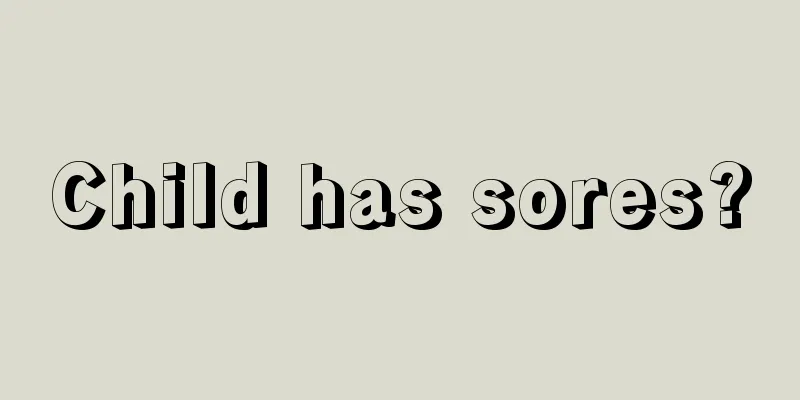What are the symptoms of otitis media in babies?

|
I believe some parents have more or less some understanding of the disease of otitis media. It is a relatively common children's disease. Many parents do not know much about it, so even if their babies have otitis media, they fail to discover it in time, thus delaying the best time for treatment. So what are the symptoms of otitis media in babies? What is otitis media Otitis media is an inflammation of the middle ear and is a common cause of ear pain in children. Otitis media is more common in children under 8 years old. It is often a painful complication of an upper respiratory tract infection, such as the common cold or throat infection. Symptoms of otitis media in children: (1) Early stage (medically known as Eustachian tube obstruction stage): Children may show symptoms such as lack of energy, loss of appetite, tinnitus, and ear discomfort (children cannot express themselves), but ear discomfort will affect the baby's play and sleep. During this period, doctors may find that the eardrum (medically called tympanic membrane) is sunken and there is fluid in the middle ear. (2) Progressive stage (medically known as the pre-suppurative stage): manifested by high fever, body temperature can reach 39℃~40℃, crying and restlessness, hearing loss and ear pain in children, accompanied by gastrointestinal symptoms such as nausea, vomiting, diarrhea, etc. These symptoms are similar to those of a cold or enteritis and are easily ignored or misdiagnosed. After examination, it can be found that the eardrum is congested and the auditory ossicles are red, swollen and bulging. (3) Peak stage (medically known as the suppurative stage): Children have high fever and refuse to eat. In severe cases, they have a gray complexion, fluctuating tinnitus, hearing loss, and ear pain radiating to the surrounding areas. Examination may reveal a bulging eardrum and pus in the middle ear. (4) Late stage (medically known as the dissipation stage): Generally, 4-5 days after the onset of the disease, the child's body temperature drops, the ear pain disappears, and the child can fall asleep, but the eardrum ruptures, pus flows out of the ear canal, and tinnitus and hearing loss still exist. Treatment of otitis media in children Special reminder: Not every baby with otitis media will have four clear stages, and it is often difficult to distinguish the specific stage of the disease, so young parents should not force it. The important thing is to be vigilant. The earlier the diagnosis and treatment are discovered, the better the effect. If the above symptoms occur, parents should take their children to the hospital for treatment, and the doctor will use an otoscope to examine the child's ears. If there is exudate in the ear, it can be collected to identify the microorganism causing the symptoms. Your child's doctor may give him or her a course of antibiotics. Sometimes, ear fluid may remain in the ear for up to 3 months, so children may still have some hearing loss. A ruptured eardrum will heal in about a week. 3 months after the child develops otitis media. Your child's doctor may retest your child's hearing to make sure it's back to normal. If your child still has hearing problems, wet ear may be the cause. With treatment, the Eustachian tube will gradually widen as your child grows, allowing the fluid to drain more easily. As a result, the middle ear is less susceptible to infection. After children are 7 or 8 years old, otitis media is less likely to occur. The above is an introduction to the symptoms of otitis media in babies and some treatment methods. If a child suffers from otitis media, parents can use some of the methods introduced above to help the child relieve and treat the symptoms, and strive to get the child out of the pain as soon as possible. Finally, parents are reminded that babies under eight years old are very likely to suffer from otitis media, so they must pay more attention to it. |
<<: What are the folk remedies for treating acute sinusitis in babies?
>>: Why is my baby having trouble breathing?
Recommend
Why are eight-month-old babies' legs weak?
An eight-month-old baby should be able to sit up ...
When the baby got up, the mother's behavior actually hurt the child!
For parents, waking up their children in the morn...
What to do if your baby has nasal mucus
Having nasal mucus is a normal physiological phen...
What should children with amblyopia eat for their eyes?
Amblyopia is a common eye disease, which brings m...
What causes dark circles under baby's eyes?
Speaking of dark circles, everyone knows that it ...
What is the cause of blood in children's stool?
The most common cause of bloody stools in childre...
Newborns stretch frequently
In everyone's impression, all newborn babies ...
What are the cough and phlegm-relieving soups for children?
When a child has a cough or is elastic, as a moth...
What should I do if my child has a runny white nose?
For younger children, their body's self-defen...
How to treat sinusitis in children?
We always give special care to the growth of chil...
Two and a half year old baby education
Many mothers are more concerned about whether the...
What should I do if my child has a big bump on his forehead?
Bumps and bruises are inevitable in life. Every c...
What should I do if my baby always has eye mucus?
The baby always has eye mucus. Mostly it’s becaus...
What causes high TSH in newborns?
Neonatal tsh refers to the thyroid function statu...
What should I do if my one and a half year old baby has skin allergies?
Babies who are one and a half years old have basi...









